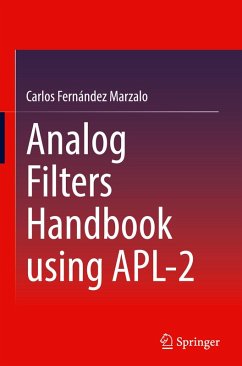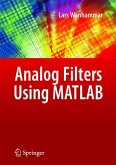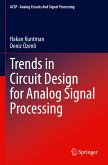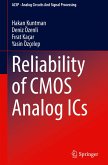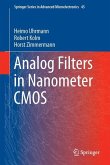This book describes the analog filter synthesis method proposed by Darlington but adapted to current calculation capabilities. It is an eminently practical text, and its readers must have basic knowledge of network theory, signal theory and notions of complex variable calculation. Unlike other publications, the main purpose of the Analog Filters Handbook using APL-2 is to accompany the engineer throughout the design cycle of a filter with the peculiarities that the designer has imposed to solve a specific problem.
The Analog Filters Handbook using APL-2, in addition to including the usual calculation procedures, includes Newton-Raphson debugging procedure.
The Analog Filters Handbook using APL-2 reviews the fundamental topics in the synthesis of dipoles such as the natural frequencies and positive real functions. It is important to highlight the generalization of the canonical form of Foster, which makes it possible to obtain the residual function, after removing a pole, in a way that can be approached by automatic calculation. However, the reader may skip them without losing the continuity of the explanation.
The Analog Filters Handbook using APL-2 develops a thorny topic such as that of filters with coupled resonators and presents a novel path for their synthesis. The study of stepped filters, very little developed in the specialized literature, is also addressed.
The Analog Filters Handbook using APL-2 develops the procedures to design any loss function using active circuits by means of the automatic "chopping" of the transfer functions into basic cells.
The Analog Filters Handbook using APL-2 deals extensively with the topic of equalizers, both phase and amplitude. Finally, the Hilbert and Shelving-type audio-frequency filters are developed.
The Analog Filters Handbook using APL-2 is primarily intended for analog and RF circuit engineers, graduate students, and RF CAE software engineers.
The Analog Filters Handbook using APL-2, in addition to including the usual calculation procedures, includes Newton-Raphson debugging procedure.
The Analog Filters Handbook using APL-2 reviews the fundamental topics in the synthesis of dipoles such as the natural frequencies and positive real functions. It is important to highlight the generalization of the canonical form of Foster, which makes it possible to obtain the residual function, after removing a pole, in a way that can be approached by automatic calculation. However, the reader may skip them without losing the continuity of the explanation.
The Analog Filters Handbook using APL-2 develops a thorny topic such as that of filters with coupled resonators and presents a novel path for their synthesis. The study of stepped filters, very little developed in the specialized literature, is also addressed.
The Analog Filters Handbook using APL-2 develops the procedures to design any loss function using active circuits by means of the automatic "chopping" of the transfer functions into basic cells.
The Analog Filters Handbook using APL-2 deals extensively with the topic of equalizers, both phase and amplitude. Finally, the Hilbert and Shelving-type audio-frequency filters are developed.
The Analog Filters Handbook using APL-2 is primarily intended for analog and RF circuit engineers, graduate students, and RF CAE software engineers.

